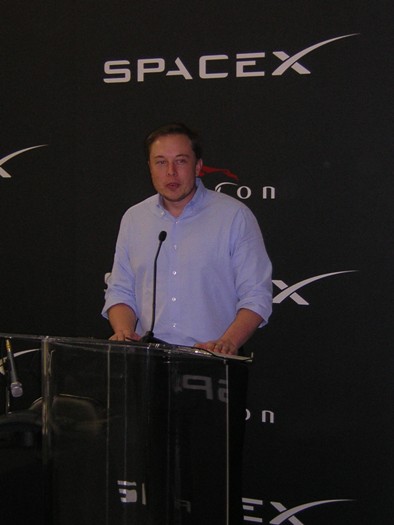
I took a lot of notes at the SpaceX press conference in El Segundo today, but I think that the proceedings will be available at their web site, so I’ll just put down some highlights and thoughts. While I was there, I’m probably less valuable as a reporter than as a participant, because I asked several questions. Fortunately (for me, though not necessarily for the company from a PR standpoint), as I noted earlier, the attendance by the media was sparse, so I was front and center, with an opportunity to almost interview Elon in real time. I should note that he didn’t say a lot that was new here, but it was a good opportunity to hear it all in one place at one time. This may ramble a little, because I’m one of those guys in their pajamas who don’t have editors…
He was clearly confident and happy with the current situation. When asked if he was nervous, he responded that he was actually relieved, because he feels that they’ve now done everything possible (or at least reasonable) to ensure success of this critical first launch, and are “at peace with themselves.”
I think that what came through most to me was that there is clearly a vision to this venture, and that while he’s happy for the business from DARPA and the Air Force, the ultimate purpose is not to deliver military satellites cheaper.
He is clearly doing this because he believes that it is important, even imperative, that we help life expand out into the universe (he even explicitly said that–unlike many, he didn’t do this to get himself into space–he did it so others could). That’s not a usual motivation (at least voiced) for an entrepreneur, and it could cause some stockholders to be concerned that it will take primacy over returns, but this is mitigated by the fact that he is clearly a successful businessman with a track record.
Along those lines, when asked about his lawsuit against Boeing and Lockmart, he noted that many times, if there were victories in such things, they were often posthumus. He said that he wanted his legal victory to be “prehumus.”
He gave some hint of what he has in mind for a tourist market, mentioning that a Falcon 9 could deliver a “loop around the moon.” One more bit of evidence (besides the launch contract) that he’s been talking to Bob Bigelow.
Some interesting (to me) tidbits:
- This will be the first orbital launch from Kwajalein
- The Merlin II engine will be the largest (by thrust) in the world (though not in history–it won’t beat the F1)
- First stage is most mass efficient in the world
- Second stage is most mass efficient in the world for a pressure-fed engine
- He’s planning to raise funds early next year to complete Falcon 9 (he thinks he needs another hundred million) but will fund it himself if this is unsuccessful
- He’ll be designing the Falcon 9 to 40% structural margin (airframe, meaning passengers) rather than the traditional unmanned spacecraft margin of 25%, and make it triple redundant (rather than the single-string Falcon 1)
- He agrees that “human rating” may be a chimera, and agrees that it’s senseless to design a vehicle to less reliability for hundred-million-dollar satellites than for people
- He’s encouraged by recent legislation, and will lobby for ITAR relief (specifically mentioning the ridiculous situation that we treat Canada and New Zealand exactly like North Korea), but it isn’t the company’s highest priority
- He’s had dinners with Jeff Bezos, and he shares the vision for expanding humanity into space, and they may collaborate at some point, but there are no specific plans
- Paul Allen may be visiting the plant soon, but has expressed no explicit interest in investing
He did say one thing that concerned me. When asked if he had considered a dummy upper stage on a first-stage test, he pointed out that Apollo had tested all up. I’m not sure that Apollo was the best model to follow, given that they had unlimited funds, and were in a race. Also, he said that he thought a successful launch would validate their design, but he’s mistaken about that. It might merely validate their luck. You can’t go and focus on manufacturing quality from a single successful launch–it will take many launches to develop a level of confidence in both design and manufacturing. I hope that they will rethink this philosophy.
Overall, though, I was encouraged, and will be cheering for them next Friday.
[Update late evening]
Michael Belfiore was live blogging it. Clark Lindsey also has good notes.
